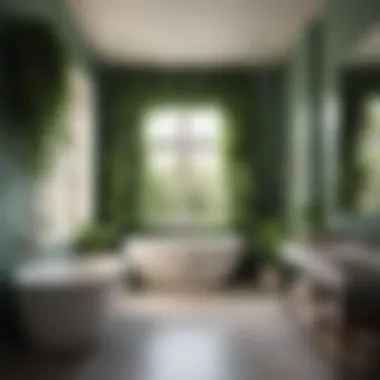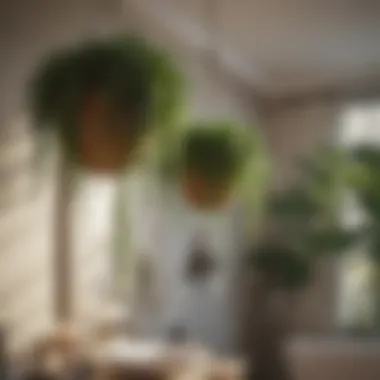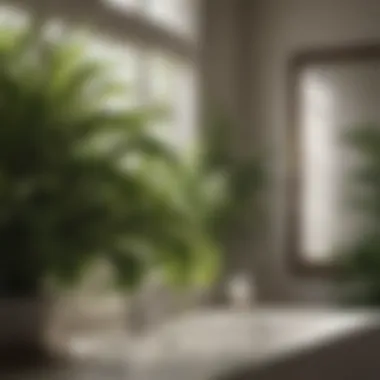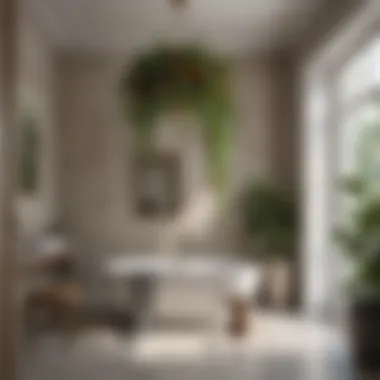Explore the Best Hanging Plants for Bathrooms


Intro
Bathrooms often take a backseat when it comes to home decor. However, incorporating plants can breathe life and freshness into these spaces. Hanging bathroom plants not only enhance the visual appeal but also contribute to improved air quality. The ideal plant choice hinges on understanding each plant's specific requirements, such as humidity levels, light conditions, and maintenance needs.
Homeowners and renters alike can benefit from this guide. This article explores various aspects of selecting and caring for hanging plants, as well as practical installation strategies. By the end, you will have the tools to transform your bath into a sanctuary.
Understanding the significance of air purification and aesthetic enhancement in a confined space is vital. Bathrooms, which are often humid environments, favor certain plant varieties that thrive in moisture. This article will delve into optimal choices and practical tips for achieving a lush, vibrant atmosphere.
Design Inspirations
In the world of interior design, bathrooms are evolving. The latest trends emphasize natural elements, where incorporating greenery plays a significant role. Adding hanging plants can create a soothing environment, turning a mundane area into an oasis of serenity.
Latest Trends in Bath and Bedroom Design
Open-concept layouts and minimalistic designs are popular, making the integration of plants crucial in enhancing the overall aesthetic. Plants like Philodendron or Pothos are often favored due to their trailing leaves and adaptability. Adding these plants not only refreshes the room but also aligns with the modern trend of incorporating nature indoors.
Color Palettes and Themes
When choosing plants, consider how their colors can complement your bathroom's theme. For neutral palettes, plants with vivid green hues add a lively touch. For bold settings, such as those with darker tiles or walls, lighter-colored plants like Spider Plant create contrast and visual interest. Keep in mind that the right color balance enhances overall decor.
Functional Elements
In addition to aesthetics, functionality in small spaces is key. Hanging plants should not only look good but also serve a purpose. The right plant can help in optimizing space, especially in bathrooms where surface area is often limited.
Space Optimization Tips
Utilizing vertical space is essential. Consider installing shelves or hooks in your bathroom to maximize area. Plants such as Bamboo and String of Hearts can be hung from these spaces to create dynamic displays. This results in an open feel without sacrificing utility or comfort.
Multi-Functional Furniture Choices
Selecting multi-functional pieces can further enhance your bathroom's efficiency. From cabinets with built-in plant shelves to towel racks that feature hanging planters, integrating plants with furniture improves both the aesthetic and functional aspects of the bathroom.
To sum up, choosing the right hanging bathroom plants demands thoughtful analysis of design inspirations and practical functionality. This exploration will help in selecting plants that not only flourish but also resonate with your personal style.
Prologue to Hanging Plants in Bathrooms
Hanging plants offer a unique way to incorporate greenery into a bathroom space. This article explores various aspects of choosing and maintaining these plants. Bathrooms often have specific challenges like humidity and light availability. Understanding these factors can help you select the right hanging plants.
Significance of Indoor Plants
Indoor plants are not simply decorations; they contribute significantly to the overall well-being of a household. They improve air quality by filtering toxins and providing essential oxygen. Additionally, they can enhance mood and reduce stress levels.
Many people, especially those with busy lives, may not have time to tend to traditional gardening. Therefore, indoor plants can be a practical solution for infusing nature into daily life. For a housewife or homeowner, these plants can transform a space into a serene retreat, creating a pleasant environment for relaxation.
Benefits of Hanging Plants
Hanging plants provide an array of benefits that make them suitable for bathroom settings.
Space Optimization: Bathrooms typically have limited floor space. By using hanging plants, you can effectively utilize vertical space while keeping the area organized and tidy.
Humidity Control: Bathrooms are often humid. Many indoor plants thrive in these conditions, making them suitable for hanging arrangements.
Aesthetic Appeal: Hanging plants can enhance the visual appeal of any bathroom. They add color and texture, which can break the monotony of tiles and painted walls.
Low Maintenance: Many options require less care than traditional house plants, making them ideal for busy individuals.
Incorporating hanging plants into your bathroom can instantly elevate both its appearance and environmental quality.
This thoughtful approach to home decor ensures you make the most of your bathroom space while enjoying the benefits of indoor greenery.


Criteria for Selecting Bathroom Plants
Selecting the right plants for your bathroom involves thoughtful consideration of various factors. The bathroom environment differs from other spaces in the house due to unique conditions, such as humidity and light levels. This section will highlight important criteria to keep in mind when choosing plants for this specific area.
Understanding Bathroom Conditions
Humidity Levels
Humidity in bathrooms often remains high due to regular use of water for bathing and washing. This characteristic can substantially influence plant health.
Certain plants thrive in humid environments, making them suitable choices for bathrooms. High humidity can promote the growth of tropical plants like ferns and peace lilies. This means that they can develop lush foliage, which enhances the aesthetic appeal of the bathroom.
However, some plants may struggle in high humidity if they are not adjusted properly or if overwatering occurs. For instance, while pothos enjoys moisture, excessive dampness can lead to root rot.
Therefore, when considering the humidity levels, it's essential to evaluate how much water a plant requires and how it reacts to added moisture.
Light Exposure
Light exposure in bathrooms can vary considerably depending on window placement and size.
Good light is essential as it helps plants photosynthesize, which affects their overall health and growth.
Plants like snake plants and pothos can tolerate low light conditions, making them great for bathrooms with limited natural light.
On the contrary, light-loving plants, such as English ivy, will not thrive without sufficient sunlight. Selecting plants that align with the light exposure in your bathroom ensures they will flourish rather than languish. Therefore, knowing the bathroom's light conditions is vital for optimal plant selection.
Maintenance Requirements
Watering Needs
Watering needs vary greatly among different plants. Some species like the spider plant prefer a consistent moisture level, while others such as succulents need to dry out between watering.
Understanding these requirements can prevent over or under-watering, both of which harm the plants.
Plants requiring less frequent watering might be a better choice for those who travel often or lead busy lives. Balancing between plant type and your personal routines is key for long-term success.
Fertilization
Fertilization is another element that influences plant health. Many plants in humid environments benefit from regular feeding during their growing seasons.
Using a balanced fertilizer can boost growth and vibrant foliage. Yet, it is important to recognize that not all plants have the same fertilization needs.
Some might be more forgiving in terms of nutrient deficiency, while others may show signs of stress. Understanding the specific requirements of each plant type helps maintain an enriching environment that supports their growth.
Top Recommendations for Hanging Plants
This section emphasizes several optimal choices for hanging bathroom plants. The selection of the right plants is fundamental to enhancing both aesthetics and air quality in bathroom spaces. Each recommended plant brings unique characteristics and care requirements, allowing homeowners and renters to find options that fit their specific needs.
Pothos
Characteristics
Pothos is known for its heart-shaped leaves that can vary in color. This plant is a popular choice for many reasons. Its trailing nature allows it to cascade down from shelves or hanging pots beautifully. The adaptability of Pothos to various light conditions makes it suitable for bathrooms, which might lack direct sunlight. Moreover, it has a robust nature that tolerates neglect, making it perfect for those who may not be able to maintain a meticulous care routine.
Care Tips
When caring for Pothos, it is recommended to water it when the top inch of soil feels dry. This method helps avoid overwatering, which is one of the most common mistakes. Fertilization can be done every few months to encourage growth, but the plant generally thrives without much innovation. Pothos can also grow well in lower light, although a little bit of indirect sunlight encourages better vigor.
Spider Plant
Characteristics
The Spider Plant features long, arching leaves with a striking green hue. Its ability to produce offshoots, known as 'pups,' allows for easy propagation. This resilience is another reason why it fits well in bathroom environments. Spider Plants are effective at improving indoor air quality, filtering out pollutants, and providing oxygen, enhancing the wellness aspect of the space.
Care Tips
For optimal care, it is best to keep the Spider Plant in a brightly lit area without direct sunlight. Watering can be done when the topsoil appears dry, usually once a week. They are relatively low maintenance and, generally, do not require much fertilizer. However, a balanced liquid fertilizer during the growing season can promote the growth of their beautiful pups while maintaining healthy foliage.
English Ivy
Characteristics


English Ivy has charming, lobed foliage that adds distinct character to spaces. It thrives in high humidity, making it a natural fit for bathrooms. One of its notable characteristics is its climbing ability, which allows it to trail elegantly from its hanging pot. This plant also has air-purifying qualities, contributing to a healthier indoor environment.
Care Tips
English Ivy prefers to be watered when the soil surface dries out. It performs best in a slightly humid environment, so regular misting or a pebble tray can enhance its growth. Be aware that this plant can be sensitive to prolonged dry conditions, and overwatering can lead to root rot, so balance is important.
Boston Fern
Characteristics
The Boston Fern is famed for its lush, feathery fronds. It prefers humid environments, making bathrooms an ideal locality. The plant adds a touch of vibrancy and elegance, serving both decorative and functional purposes. Its resilience to varying light makes it a versatile option.
Care Tips
To care for a Boston Fern, it is essential to keep it consistently moist, as these plants thrive in damp conditions. Check the soil regularly to avoid drying out. Light exposure should be indirect, as direct sunlight can scorch its tender leaves. Using a slow-release fertilizer every few months can provide necessary nutrients for ongoing health.
Philodendron
Characteristics
Philodendron is recognized for its diverse varieties and attractive foliage. Its leaves can vary in size and shape, adding visual interest to any bathroom. This plant is particularly resilient and can thrive in a range of conditions. It’s a favorite among plant lovers due to its stylish appearance and air-purifying properties.
Care Tips
When caring for Philodendron, allow the soil to dry out slightly between watering. This plant prefers bright, indirect light but can adapt to lower light environments. It requires minimal fertilization, making it low-maintenance. However, regular pruning will encourage bushier growth while maintaining its appealing look.
Conclusion: Each of the plants mentioned here provides unique attributes and care tips, making them suitable for enhancing hanging spaces in bathrooms. Proper selection can lead to a vibrant, healthier, and visually pleasing environment.
Installation Strategies for Hanging Plants
Selecting the right installation strategy for hanging plants in bathrooms is vital for their health and your convenience. Proper placement ensures that the plants receive adequate light and air circulation while also enhancing the aesthetic of the space. The strategies you choose can significantly impact the overall success of your hanging plants. Understanding the selection and installation process will help you make the most out of your green additions to the bathroom.
Choosing the Right Pot
Choosing the right pot is an essential step in the installation process. The pot needs to be well-draining, allowing excess water to escape. Consider materials like terracotta or ceramic, as they help regulate moisture levels. Additionally, the size of the pot should complement the space. A smaller pot can give the illusion of more room, while a larger pot may require more installation planning. Equally important is to ensure that the pot has sturdy hooks or attachments for hanging, which will secure the plant safely.
Suspension Options
When it comes to hanging plants, how they are suspended is just as important as the pot itself. There are various suspension options to consider, each with its unique characteristics.
Hanging Brackets
Hanging brackets are a popular choice for suspending plants due to their simplicity and stability. They can be attached directly to walls or ceilings, offering strong support.
- Key Characteristic: Made typically from metal or wood, hanging brackets can accommodate different pot sizes.
- Benefits: They provide a robust method for securing plants overhead, making them less likely to topple.
- Unique Feature: Some brackets come with adjustable lengths, allowing for customization of plant height.
- Advantages/Disadvantages: While they are reliable and sturdy, installing brackets may require drilling into your wall, which some homeowners might find unwelcome.
Ceiling Hangers
Ceiling hangers are another option worth considering. These systems generally involve hooks or cables, utilizing the ceiling space to create a floating effect.
- Key Characteristic: They can be both decorative and functional, often showcasing beautiful designs.
- Benefits: Ceiling hangers maximize vertical space and can create an open atmosphere in smaller bathrooms.
- Unique Feature: Some advanced ceiling hangers allow for adjustable height, which can be especially useful in rooms with varying ceiling heights.
- Advantages/Disadvantages: While they enhance the visual appeal, ceiling hangers may require more effort for installation and could limit plant choice based on the allowed weight.
Proper installation techniques for hanging plants can significantly affect their growth and visual appeal.
Understanding these installation strategies can help you choose the best methods to showcase your plants effectively. Adopting the right combination of pots and suspension options will not only enhance the beauty of your bathroom but also support the health of your plants.


Care and Maintenance of Hanging Bathroom Plants
Caring for hanging bathroom plants is essential for several reasons. First, proper maintenance ensures that these plants thrive in the unique conditions of a bathroom, promoting not only their health but also enhancing the overall aesthetic of the space. A well-maintained plant contributes to the air quality while creating a serene environment. Moreover, understanding the specific needs of each species allows homeowners to avoid common pitfalls and prolong the life of their green companions. This section delves into two critical aspects of plant maintenance: watering techniques and pest management.
Watering Techniques
Watering is a fundamental aspect of plant care. For hanging plants in a bathroom, understanding the moisture needs is crucial. Most indoor plants prefer a consistent watering schedule that reflects the humidity and light conditions of the area.
Here are some strategies to ensure proper watering:
- Check Soil Moisture: Before watering, always check the soil’s moisture level. Insert a finger about an inch into the soil. If it feels dry, it is time to water.
- Use Room Temperature Water: Cold water can shock the plant. Using water at room temperature helps in maintaining a stable environment.
- Avoid Overwatering: Hanging plants often retain more moisture due to their position. Too much water can lead to root rot. Be cautious and only water when necessary.
- Consider Drainage: Ensure that pots used for hanging plants have proper drainage. This prevents excess water from accumulating at the bottom, which can create a hostile environment for roots.
By following these techniques, you can help your plants to thrive without complications.
Pest Management
Keeping hanging plants free from pests is essential to their health and the appearance of your bathroom. Common issues include aphids, spider mites, and whiteflies, which can damage the foliage and overall plant vitality. Pest management should incorporate both preventive measures and solutions for infestations.
Consider the following approaches:
- Regular Inspections: Check your plants frequently for signs of pests. Look under leaves and at the stems where pests often hide.
- Maintain Hygiene: Wipe down the leaves regularly with a damp cloth to remove dust and potential eggs. This simple act can prevent infestations.
- Natural Remedies: Use natural insecticidal soap or neem oil as effective treatments for minor pest problems. They tend to be less harmful to the plants and the environment.
- Isolation: If a plant shows signs of an infestation, separate it from other plants to prevent the spread of pests.
These strategies assist in keeping your plants healthy and beautiful, further enhancing your bathroom's ambiance.
"A little attention can prevent most pest issues and keep your hanging plants thriving in your bathroom."
By understanding both watering techniques and pest management, homeowners can create an environment where hanging plants flourish. This care will lead to a more vibrant and inviting bathroom space.
Common Issues with Hanging Plants
Hanging plants can transform a bathroom ambience, yet they come with their own set of challenges. Understanding these common issues is crucial for maintaining the health and longevity of these plants. By recognizing potential problems early, homeowners can make informed decisions, ensuring their plants remain vibrant and contribute positively to their space. In this section, we will discuss two primary issues that may arise: leaf discoloration and stunted growth. Each problem not only affects the aesthetic of the plant but also indicates underlying care or environmental factors that need attention.
Leaf Discoloration
Leaf discoloration is a frequent occurrence in hanging plants, serving as a visual cue that something may be amiss. This issue can present itself in various forms, from yellowing leaves to browning tips. Understanding the reasons behind this discoloration can help in diagnosing care problems effectively.
- Overwatering: Excessive moisture can lead to root rot, causing leaves to yellow. Check if the soil is soggy and let it dry out before watering again.
- Underwatering: On the opposite end of the spectrum, insufficient watering can cause leaves to dry out and turn brown. Regular checks on the soil moisture help maintain the right balance.
- Nutrient Deficiency: A lack of essential nutrients, particularly nitrogen, can manifest as yellowing leaves. Consider using appropriate fertilizers to enrich the soil.
- Light Exposure: Insufficient light may also lead to pale leaves. Ensure plants receive adequate light suited to their needs, as different species have specific light requirements.
Monitoring leaf condition regularly allows for timely recognition of issues. Addressing them promptly can prevent further complications and maintain the health of your hanging plants.
Stunted Growth
Stunted growth can be frustrating for any plant enthusiast. It often indicates that the plant is not thriving, thus impacting its overall health and appearance. There are several factors that can lead to this condition.
- Pot Size: A plant's growth can be significantly hindered if it is in a pot that is too small. This can restrict root expansion. Repotting into a larger container may provide the necessary space.
- Lack of Light: Without adequate light, photosynthesis slows down, stunting growth. Placing your plant in a well-lit area can enhance growth potential.
- Inconsistent Watering: Both over and underwatering can contribute to growth issues. Regularly assess soil moisture and adjust watering schedules accordingly.
- Pest Infestation: Pests can weaken plants and hinder growth. Regular inspections and prompt treatment of any infestations are essential to ensure plants remain healthy.
Understanding these factors is essential for any enthusiast. By paying close attention to both symptoms and their underlying causes, one can create a thriving environment for hanging bathroom plants.
Ending
The conclusion serves an essential role in distilling the insights presented in this article on hanging bathroom plants. It provides an opportunity to reflect on the importance of careful selection and maintenance of such plants in transforming bathroom spaces into healthier and more aesthetically pleasing environments. Hanging plants transcend mere decoration; they contribute to improved air quality and moisture control, proving invaluable in an often overlooked area of the home.
Final Thoughts on Enhancing Bathroom Spaces
Selecting the right hanging plants requires consideration of various elements such as light conditions and humidity. These factors are critical in determining not only the viability of the plants but also their growth and longevity. Homeowners should consider plants like Pothos and Spider Plants for their resilience and air-purifying capabilities. Incorporating these plants into bathroom design can have numerous benefits:
- Aesthetic Appeal: Vibrant greenery can enhance the overall look of the bathroom.
- Air Quality Improvement: Plants actively filter common toxins, enhancing the space's air quality.
- Humidity Control: Plants can help manage humidity levels, preventing mold growth and damage.
It is crucial for homeowners and housewives to evaluate their specific conditions, factoring in their bathing habits, the presence of windows, and ventilation. By taking the time to understand the needs of both the plants and the bathroom environment, individuals can create a harmonious space that is both functional and visually appealing.
"Integrating nature into your bathroom with hanging plants is not just a trend, it’s a step towards a healthier living space."















